Plus Free Beginner Crochet Patterns for a Scarf and Dishcloth
Learn How to Single Crochet, for Beginners — Plus Get Free Beginner-Level Crochet Patterns for a Scarf and Dishcloth.
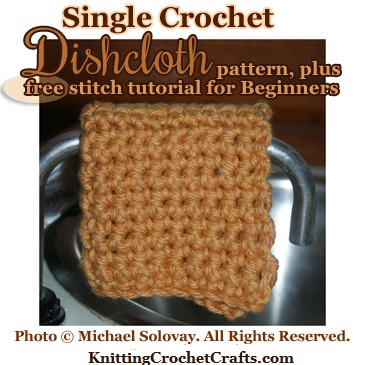
You can use the following instructions to learn how to do one single crochet stitch. If you want to learn how to make an entire fabric in single crochet stitch, you’ll need these instructions plus the instructions included in the section that follows.
You’ll want to begin with an active loop on your crochet hook. If you already worked a starting chain, or some other crochet stitches, you’ll already have an active loop to work with.
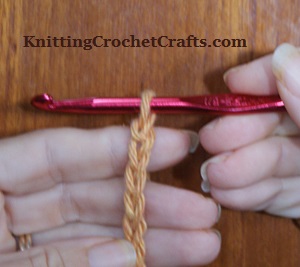
Insert your crochet hook into the spot where you want to work your single crochet. This spot could be any of the following:
- It could be a crochet starting chain, as pictured above. In that case, most of the time you’ll want to work into the second chain from your hook. There are exceptions to this, so if you are working from a pattern that tells you something different, follow the pattern instructions.
- It could be just about any crochet stitch.
- It could be a ring that you made by joining chain stitches with a slip stitch.
- It could be a chain-space.
- It could be a stitch in a knitted fabric.
- It could be an embroidery stitch, such as a blanket stitch or an embroidered chain stitch.
- It could be a loosely woven fabric; if you can poke a crochet hook through the fabric, you can work a single crochet stitch into it.
- It could be an object that isn’t even made of fabric — for example a pull tab, a set of purse handles, a piece of metal jewelry hardware, or a piece of leather that you’ve punched a hole in with a leather-working tool.
In some of the cases above, you won’t already have an active loop on your hook to work with when you begin your single crochet stitch. If you’re crocheting into a piece of woven fabric, or another object, you’ll want to start by making a slip knot, which will give you an active loop to work with.
Find the end of your yarn, thread or fiber that’s attached to your ball or skein. Grab the yarn with your crochet hook, and pull it through.
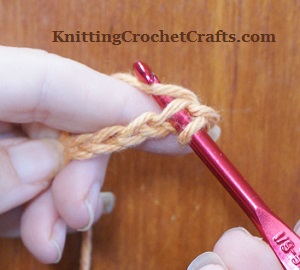
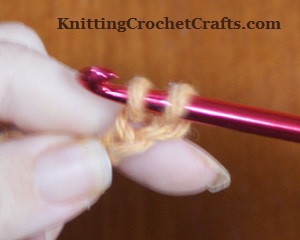
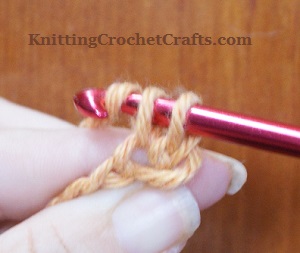
Wrap the yarn over your hook and pull it through both the loops on your hook.
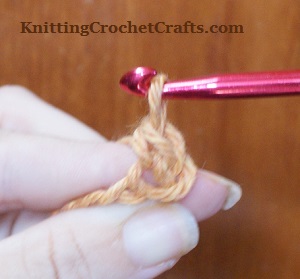
That’s one single crochet stitch, completed.
How to Do Single Crochet Stitch Worked in Rows
Crochet a starting chain comprised of multiple chain stitches — at least 3, but preferably more.
Beginner’s Scarf and Dishcloth Patterns: If you’d like to crochet a useful project at the same time you learn and practice, you could try making either a scarf or a dishcloth.
For either project, you’ll want to use a size I / 9 crochet hook, plus medium-weight yarn rated as a 4 on the Craft Yarn Council’s yarn weight standards system. For the dishcloth, I recommend using organic cotton yarn. For the scarf, you can use the yarn of your choice. Do keep in mind that it will be worn next to the skin, so it’s a good idea to choose a soft yarn.
For either a scarf or a dishcloth, you can begin by crocheting 21 chain stitches.
To work row 1, you want to single crochet in the second chain from your hook; then you want to continue working single crochet stitches — one single crochet stitch into each chain, until you’ve worked them all.
Count your stitches at this point. You should have 20 stitches total. If you don’t, something is wrong; investigate and fix it, ripping the work out if necessary until you get to the point where the mistake is. When you have the correct number of stitches, continue.
Next, you want to work one more chain stitch at the end of the row. This additional chain stitch is called a “turning chain,” because it will help you with turning the work over and crocheting back across again — which is what you’re about to do next.
So after you’ve worked your chain stitch, flip the work over so that what used to be the front of the work is now the back, and what used to be the back of the work is now the front.
Now you want to work a single crochet stitch into each stitch across the row to complete row 2. To accomplish this, you will insert your hook under both loops in the single crochet stitch in the previous row. Once you’ve worked a single crochet stitch in each stitch across the row, work another turning chain and flip your work over to the other side again.
Single crochet stitch is easy from here on out.
You just keep repeating row 2, over and over again.
After crocheting about 6 rows, measure the width of your piece.
I like both my scarves and dishcloths to be in the range of around 6 – 7 inches wide; your preference may be different. When you measure your work, check to see how wide the piece is turning out, and make sure it’s a size that would be useful to you before you continue crocheting more rows.
In the sample dishcloth pictured here, my piece is about 6 1/2 inches wide.
If you would like your finished piece to be wider, you can accomplish that in one of two ways. You can either start over and crochet more chain stitches at the beginning of the work, when you are making your starting chain; or you can try using a larger crochet hook. If your stitches are too tight, try using the larger hook. If your stitches are a comfortable tension, or too loose, it’s better to crochet more chain stitches to increase the width.
If you would like your finished piece to be narrower, you can start over and crochet fewer chain stitches at the beginning of the piece. Or you could start over using a smaller crochet hook — but I only recommend that option if your stitches seem to be too loose. If your stitches seem to be a comfortable tension, it’s better to crochet more chain stitches at the beginning.
For either a scarf or a dishcloth, you can just keep crocheting until the piece measures a good length for your intended project.
I crocheted 23 rows to make my dishcloth; you may need a different number of rows, depending on the yarn you used and your individual way of working single crochet stitches.
For a scarf, you can make it as short or long as you like, so you can just use your good judgment about when you are finished. I generally like to be able to loop a scarf around my neck once, tie the ends and then let them dangle, with enough room left over to tuck them into a jacket.
If you would like to do a quick fitting to see how the scarf fits, you will want to put a safety pin or locking stitch marker into your active loop to keep your work from unraveling.
When you are satisfied that the piece is long enough, end off and weave in your ends.
How to Do Single Crochet Stitch in the Round
You can make a circular fabric that’s comprised of mostly single crochet. For instructions on how to do that, please see this article about how to crochet a circle shape.
Find More Free Instructions for Learning Crochet Stitches
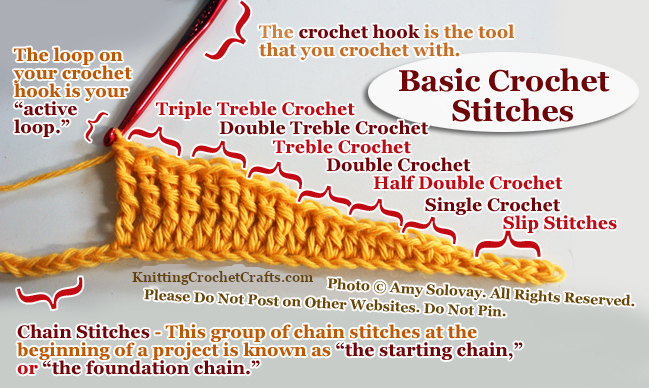
Find More Free Instructions for Crochet Stitches HERE.
Learn More About Crochet HERE.
Find Craft Project Ideas HERE.
About the Author — Amy Solovay is a freelance writer with a background in textile design. She learned to crochet as a small child. After earning two degrees, one of which is in textile design, she launched a career in the textile industry. She has worked as a textile print colorist, knit designer and director of design for various Los Angeles based fabric manufacturers. Later she transitioned to writing about crochet, knitting, crafts and other topics for major media outlets. She enjoys designing crochet and other craft patterns, and she invites you to make use of them.
This page was last updated on 5-26-2021.